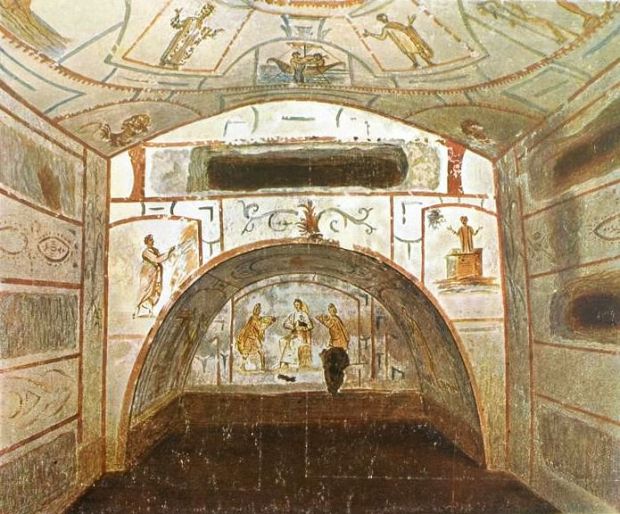The Catacombs of Marcellino and Peter stand as a testament to the early Christian presence in Rome, and to the remarkable history of the two saints they are named after. These underground burial sites hold deep significance and provide valuable insights into the lives of early Christian communities (and to those of Marcellino and Peter themselves), as well as the role of Emperor Constantine in constructing a memorial complex that included the tomb of his mother, Helena.
Marcellino and Peter were two early Christian martyrs who faced persecution during the reign of Diocletian in the 3rd century. Marcellino, a priest, and Peter, an exorcist, were known for their unwavering commitment to serving the Roman Christian community, despite the risks involved.
Both Marcellino and Peter met their tragic fate when they were arrested and executed for their faith. The exact circumstances of their martyrdom are somewhat unclear, but what is known for certain is that their remains were laid to rest in the catacombs on the Via Labicana in Rome, which later came to be known as the Catacombs of Marcellino and Peter.

Chris Petitt’s article for Medievalists.net notes that “the earliest evidence for this cult [the veneration of these martyrs, that is] is a monumental metric epitaph composed by Pope Damasus (366–384) and posted by the martyrs’ tomb.” Damasus claims that the story of these martyrs was told to him while a young man by the executioner of Marcellino and Peter himself.
The plaque on which the epitaph was inscribed was placed above the tomb of Marcellino and Peter. “Vandals destroyed the plaque,” Petitt explains, “but scholars have identified several fragments of it. A modern copy is seen there now." This (very lightly edited) translation was published in Professor Dennis Trout’s book Damasus of Rome: The Epigraphic Poetry:
Marcellino, (the story of) your grave and likewise Peter’s
an executioner told to me, Damasus, when I was a boy:
A savage butcher (he said) had given him these orders—
that he straightaway sever your necks in a wild thicket
so that no one could recognize your tomb.
You (he said) had cheerfully dug your own graves with your own hands,
which afterwards, had simply lain hidden below a cavern.
Thereafter Lucilla, alerted through your duty and your love,
was pleased to set your most holy limbs in this place.
The catacombs of Marcellino and Peter gained further significance during the reign of Emperor Constantine, who ascended to the throne in the early 4th century and subsequently became the first Roman emperor to embrace Christianity. Saying that Constantine’s reign had a profound impact on the history of the Christian Church is an understatement.
One of Constantine’s most notable projects was the creation of a grand memorial complex dedicated to Marcellino and Peter. This memorial complex encompassed the catacombs and included a magnificent basilica built on the site. The basilica served as a place of worship and veneration for the faithful, allowing them to pay homage to the memory of these revered martyrs.
Within this memorial complex, Constantine also commissioned the construction of a tomb for his mother, Helena. Helena was a devout Christian herself and played a significant role in her son’s conversion to Christianity. She is best known for her pilgrimage to the Holy Land, during which she reportedly discovered the True Cross of Jesus Christ.

The tomb of Helena within the Catacombs of Marcellino and Peter became a place of pilgrimage for Christians from around the world. It represented both the pious devotion of a mother and the triumph of Christianity under the patronage of the Roman Empire.
Today, the Catacombs of Marcellino and Peter remain a compelling testament to the early Christian faith and the enduring legacy of two martyrs. Visitors can explore the labyrinthine passages, adorned with intricate frescoes and tombs, and gain a glimpse into the lives and struggles of the early Christians in Rome. The complex stands as a powerful reminder of the early days of Christianity, and the indomitable spirit of those who surrender their lives for their faith.



